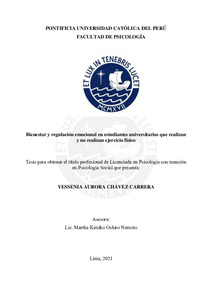Bienestar y regulación emocional en estudiantes universitarios que realizan y no realizan ejercicio físico
Abstract
El objetivo principal de la presente investigación fue comparar el bienestar y la regulación
emocional entre dos grupos, uno de estudiantes universitarios que realizan ejercicio físico y
otro de aquellos que no realizan dicha actividad. La muestra estuvo conformada por un total de
142 alumnos de una universidad privada con edades entre 18 y 28 años (M=19.95; DE=2.223).
Se usaron las escalas de Florecimiento y SPANE, adaptadas al Perú por Cassaretto y Martínez
(2017) para la medición del bienestar, y el Cuestionario de Regulación Cognitiva de las
Emociones (CERQ) validado por Domínguez y Medrano (2016) y el Cuestionario de
Regulación Emocional adaptado por Gargurevich y Matos (2010) para la medición de la
regulación emocional. Los resultados evidencian que los estudiantes que realizan ejercicio
físico presentaron mayor florecimiento y afecto positivo. Además, se evidencia mayor uso de
las estrategias de regulación emocional: reinterpretación positiva, focalización en los planes y
focalización positiva. En contraste, se evidencia mayor uso de la estrategia catastrofización en
los estudiantes sedentarios. Tomando en cuenta a la muestra total, se hallaron diferencias por
género siendo los hombres quienes presentan mayor afecto positivo y mayor uso de la estrategia
reinterpretación positiva; mientras que las mujeres, puntúan más en catastrofización. Se
encontró una correlación directa entre edad y las estrategias: poner en perspectiva y
reinterpretación positiva. Finalmente, se encontraron diferencias según las variables tipo de
ejercicio y frecuencia en relación a la regulación emocional. Se discuten estos hallazgos, así
como las limitaciones del estudio y futuras líneas a seguir. The main of the present study was to compare wellbeing and emotional regulation between two
groups, one of university students who perform physical exercise and another of regular
students. The sample consisted of a total of 142 students from a private university between of
18 and 28 years old (M = 19.95; SD = 2,223). We used The Flourishing and SPANE scales,
adapted to Peru by Cassaretto and Martínez (2017), to measure wellbeing, and The Cognitive
Emotional Regulation Questionnaire (CERQ) adapted by Dominguez and Medrano (2016) and
The Emotional Regulation Questionnaire adapted by Gargurevich and Matos (2010) to measure
emotional regulation. Results revealed that students who perform physical exercise got higher
scores at flourishing and positive affect. In addition, there is evidence of greater use of
emotional regulation strategies: positive reappraisal, refocus on planning and positive
refocusing. In contrast, there is evidence of greater use of catastrophizing strategies in sedentary
students. Considering the total simple, differences were found by gender being men who present
higher positive affect and higher use of positive reinterpretation strategy, while women score
more in catastrophizing. A direct correlation was found between age and strategies: putting in
perspective and positive reappraisal. Finally, differences were found according to the variables
type of exercise and frequency regarding of emotional regulation. These findings are discussed,
as well as the limitations of the study and the possible future lines to follow.
Temas
Bienestar
Emociones
Estudiantes universitarios--Investigaciones--Perú
Emociones
Estudiantes universitarios--Investigaciones--Perú
Para optar el título de
Licenciado en Psicología con mención en Psicología Social
Collections
The following license files are associated with this item:






